When I think of summertime, I imagine long-awaited outdoor music festivals, ice-cold cocktails on a sunny patio, and curling up in a hammock with a good book, while butterflies flit and flutter by on gentle breezes.
But my mind goes first to memories of my childhood – those seemingly endless summer days filled with the sound of flip-flops and jelly shoes slapping hot asphalt, blowing bubbles and running through the sprinkler, pumping your arms to fly as high as you could on the swing set.
That ozone smell through the screen door of a thunderstorm brewing in the distance, hunting for horseshoe crabs and building drip castles down the shore, splitting a grape two-stick popsicle with your best friend, and catching lightning bugs before bed.

We link to vendors to help you find relevant products. If you buy from one of our links, we may earn a commission.
If I had to condense all of this into a one-bite experience, here’s what it would be: the taste of a juicy, homegrown raspberry from my grandpop’s garden, just-picked and still warm from the sun.
Unless you live in the desert or the extreme frozen north, you can grow raspberries. Red, yellow, black, or purple, there’s something for just about everyone.
And whether you’re looking for an everbearing crop that will produce multiple harvests, or a big batch for canning that’s ready to pick all at once, there’s a cultivar for you.
If you’re gardening in a small space, some varieties make excellent container plantings, and self-pollinators will still produce fruit if you only have room for one plant.
There are cultivars that require a lot of pruning and tending, while others can still thrive if you like to take a more hands-off approach to gardening.
Best of all, once established, most types of raspberry will continue to produce fruit for 10 to 15 years, if not longer.
Dive into our list, and find the best varieties for your yard – you’ll be eating fresh, delicious raspberries grown in your own garden before you know it.
The Best Raspberry Varieties
Summer Bearing
These cultivars produce fruit once a year on two-year-old floricanes, typically in June or July. They may also be described as June bearing.
Summer-bearing varieties generally produce long, relatively weak canes that will require trellises for support. Do not expect a harvest in the first year.
1. Boyne (Zones 3 to 8)
Known for its excellent flavor, this variety has bright red fruit with a sweet flavor, and it does well throughout most parts of the US.
Cold hardy and known for its disease resistance, this summer-bearing cultivar will produce one harvest in early July. Canes will grow to be three to four feet tall at maturity, with an equal spread, and foliage turns orange and red in the fall.
Full sun is preferred, but ‘Boyne’ can also be grown in partial shade.
Be sure to water it well, and expect fruit on canes that are one year old, then prune them back to the ground when they have finished producing.
You can find ‘Boyne’ in five-inch and #2 containers, available from Nature Hills Nursery.
2. Cascade Delight (Zones 6 to 9)
A newer cultivar released in 2003 from Washington State University, ‘Cascade Delight’ produces large, bright red fruit with good flavor that is ready to harvest in July.
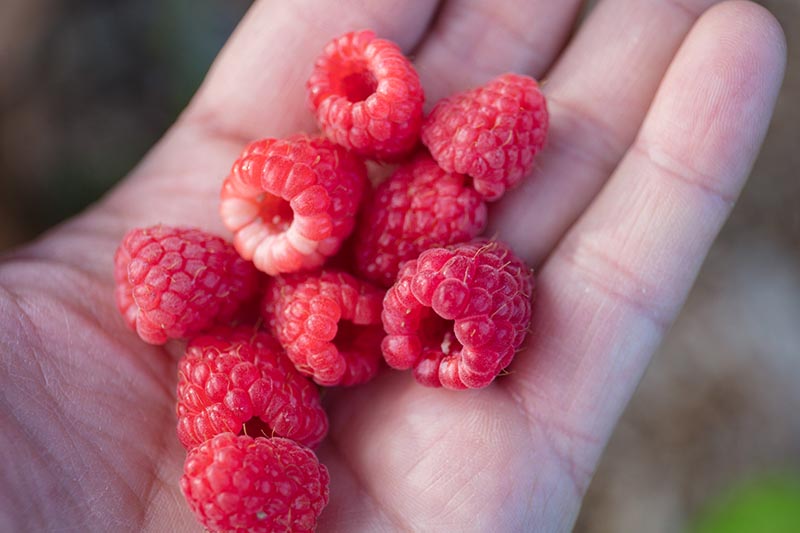
A very vigorous grower with medium to large yields, this variety is not cold hardy. It is, however, resistant to Phytophthora root rot.
Rootstock will produce fruit the year after planting, on two-year-old canes.
3. Killarney (Zones 4 to 7)
A popular cultivar since its release in Canada 1961, ‘Killarney’ is known for being extremely cold tolerant.
This summer-bearing cultivar produces medium-sized, medium to dark red fruit with a sweet, delicious flavor. Berries will be ready to harvest in July the year following planting, about a week after fruit ripens on ‘Boyne’ plants.

Upright, sturdy canes grow moderately fast, and produce medium yields. For added interest, whereas most raspberries produce white flowers in the spring, this one puts on a show of pink blooms.
Like many other disease-resistant cultivars, it is immune to Raspberry Bushy Dwarf Virus (RBDV). Moderately resistant to root rot and self-pollinating, ‘Killarney’ should be planted in full sun, in well-draining soil.
You can find ‘Killarney’ plants available from Hand Picked Nursery via Amazon.
4. Raspberry Shortcake (Zones 5 to 8)
This dwarf raspberry is perfect for small space gardeners, since it does well in containers. With a mounding habit, a mature height of two to three feet, and an equal spread, plant it in full sun.
Its compact form means it won’t require a trellis, and it is self-pollinating so you should still get a productive plant if you only have the space on your patio or balcony to grow one. Plus, it’s thornless!
‘Raspberry Shortcake’ requires regular pruning and upkeep, and may be more susceptible to disease than other varieties. Keep the soil moist, and do not allow it to dry out between waterings.
You can find ‘Raspberry Shortcake’ in #2 containers available from Nature Hills Nursery.
5. Royalty (Zones 4 to 7)
A hybrid of black and red varieties, this hardy and disease-resistant cultivar is what’s known as a “purple raspberry,” with very large fruit, and delicious flavor.
This vigorous grower will provide one big harvest (and I mean big) on established vines in mid-July.
Rubus ‘Royalty’ available from Burpee
‘Royalty’ will reach three to four feet tall at maturity, with an equal spread. And it even does well at high elevations, with some winter protection and consistent watering in the summertime.
Everbearing
Everbearing types produce fruit on primocanes (first-year canes) in the fall. Floricanes (or second-year canes) may produce a harvest again the following summer, typically in June or July. Read more about primocanes vs floricanes here.
These types tend to have a shorter stature, with sturdy canes that do not require support.
6. Anne (Zones 4 to 9)
This everbearing variety produces large golden-hued fruit, and the berries have a sweet flavor that’s described as almost tropical, with a hint of apricot.
A disease resistant cultivar that grows vigorously, ‘Anne’ was awarded for having the best taste in a comparison of raspberry varieties by the Utah State University Cooperative Extension in 2013.
Self-pollinating, you can expect harvests starting in July through the first frost, with improved flavor as the weather starts to cool off. As is the case for all patented varieties, propagation of this type is prohibited.
Cold hardy and heat tolerant as well, plant in full sun in well-draining soil. Keep in mind that this cultivar is susceptible to root rot.
You can find ‘Anne’ plants available from Home Depot or via Amazon.
7. Dorman Red (Zones 5 to 9)
An everbearing cultivar that produces sweet, red fruit in abundance on fast-growing, thornless canes, you can expect high yields on second-year canes from June through the first frost in September.
Trellising is required, to keep them from trailing along the ground.

This self-pollinating variety does well in the heat and humidity of southern climates, where other cultivars might fail to thrive. Plant ’Dorman Red’ in full sun, in well-draining soil.
Find ’Dorman Red’ plants available via Amazon.
8. Fall Gold (Zones 4 to 9)
An everbearing variety with sweet and tart, golden fruit, this moderately vigorous cultivar will provide two harvests per season on biennial canes.
With upright, thorn-covered canes that reach a height of 24 to 36 inches at maturity, this raspberry is more compact than other types, and grows well throughout most of the US if given full sun.
Actually a type of red raspberry with a mutation that prevents the production of the vibrant pigment that these berries typically have, yellow raspberries share many characteristics with red varieties in terms of care requirements.
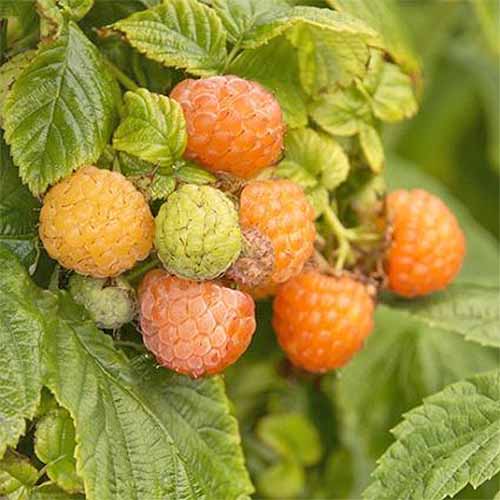
Prune ‘Fall Gold’ and other everbearing types carefully, since the fall crop will be produced on the top third of canes, with the second crop developing on the bottom two thirds of the same canes the following spring.
This cultivar is known for being cold tolerant to -25°F – talk about a hardy plant!
‘Fall Gold’ is available from Nature Hills Nursery in #1 containers.
9. Heritage (Zones 4 to 8)
Medium-sized, bright red fruit with a mild flavor, this everbearing type will produce a harvest in mid-July, and another in early September.
Disease resistant and highly productive, you can expect fruit in the first year of growth (and these grow fast).
Canes reach a mature height of three to four feet, with an equal spread. And yellow and orange fall foliage adds interest to the garden.
This variety was given the Outstanding Fruit Cultivar Award by the American Society of Horticultural Sciences in 2004.
Rubus idaeus var. strigosus ‘Heritage’ does best in full sun, though this cultivar will produce fruit in partial shade as well, and it can be grown at high elevations.
Provide some protection during the winter, and be sure to water well during the growing season. You can expect lower yields and a shorter harvest season in cold climates.
Pick up ‘Heritage’ in five-inch containers from Nature Hills Nursery.
10. Jewel (Zones 3 to 8)
Love black raspberries? Also known as ‘Jewel Black,’ this summer bearing ‘Bristol’ x ‘Dundee’ cross produces red fruit that darkens to black when ripe, in late June to early July.
The berries are medium to large and sweet, with excellent flavor and few seeds, so they’re perfect for canning.
This self-pollinating and cold hardy plant grows quickly, with 24- to 36-inch canes at maturity if planted in well-draining soil in full sun. But ‘Jewel’ can have lower yields, so plant more for cross-pollination and better harvests.
Don’t let these plants dry out in the summer, and aim to keep moisture levels steady.
Pruning is crucial – remember to cut back dead wood and all two-year-old canes to the ground in the spring, but leave the last year’s growth standing.
Experts note that black raspberries should not be planted within 75 feet of cultivars of other colors, since they may be more susceptible to diseases transmitted between plants by aphids.
You can find ‘Jewel’ available at Nature Hills Nursery and from Burpee.
11. Joan J (Zones 4 to 8)
This thornless, everbearing variety produces small to medium, sweet, firm, dark red fruit in July, August, and mid-September for medium-sized harvests.
With a mature height of four to five feet and spread of two feet, this vigorous grower should be planted in full sun. Also be sure to plant in well-draining soil, as ‘Joan J’ is susceptible to root rot.
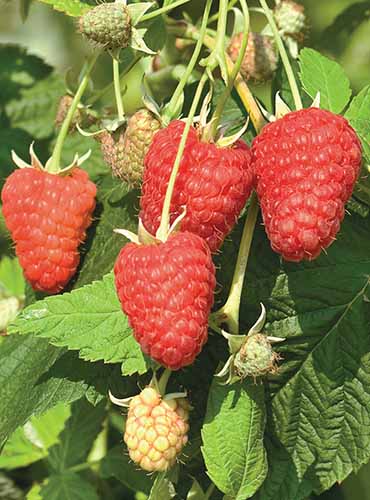
Self-pollinating and very cold hardy, you’ll get even bigger harvests if you plant it with another cultivar, such as ‘Polka.’
Find ‘Joan J’ plants available at Burpee.
12. Polka (Zones 4 to 8)
A hardy cultivar with few thorns, ‘Polka’ reaches a mature height of four to six feet with a spread of one to two feet, and abundant yields.
Juicy and sweet with a mild flavor, the berries have a pale to dark red color when they’re ready to pick.

These everbearing plants will produce fruit from July through the first frost in September, and they’re known for ripening first at the beginning of the season as well, in comparison to other varieties.
Self-pollinating and cold hardy, growing multiple plants isn’t necessary, though it will help to ensure larger harvests.
Another added benefit – it’s not very susceptible to root rot. Try companion planting with the ‘Joan J’ cultivar.
Find sets of five ‘Polka’ plants available from Hand Picked Nursery via Amazon.
13. September (Zones 4 to 8)
Everbearing with an upright growth habit, ‘September’ reaches four to six feet at maturity, with an equal spread.
Sweet red or yellow berries will reach maturity on second year canes in the summer, and again on first year canes in the fall.
Dealing with less than ideal conditions, but you’re still eager to grow raspberries?
This cultivar can grow in a variety of soil types, in full sun as well as partial sun, and it’s cold hardy as well. ‘September’ canes do have quite a few thorns, so keep that in mind, and new canes are produced via suckers.
You can find ‘September’ available from Nature Hills Nursery
A Classic Garden Favorite
Alright, raspberry lovers – I know at least one (if not several) of the cultivars on this list must have stood out to you above the rest.
Match up the items on your short list with your growing zone and available planting space and conditions, and you’re golden. Or red. Or purple…
So, pick out your favorites and get planting, or bookmark this list for when garden planning season arrives in your area.
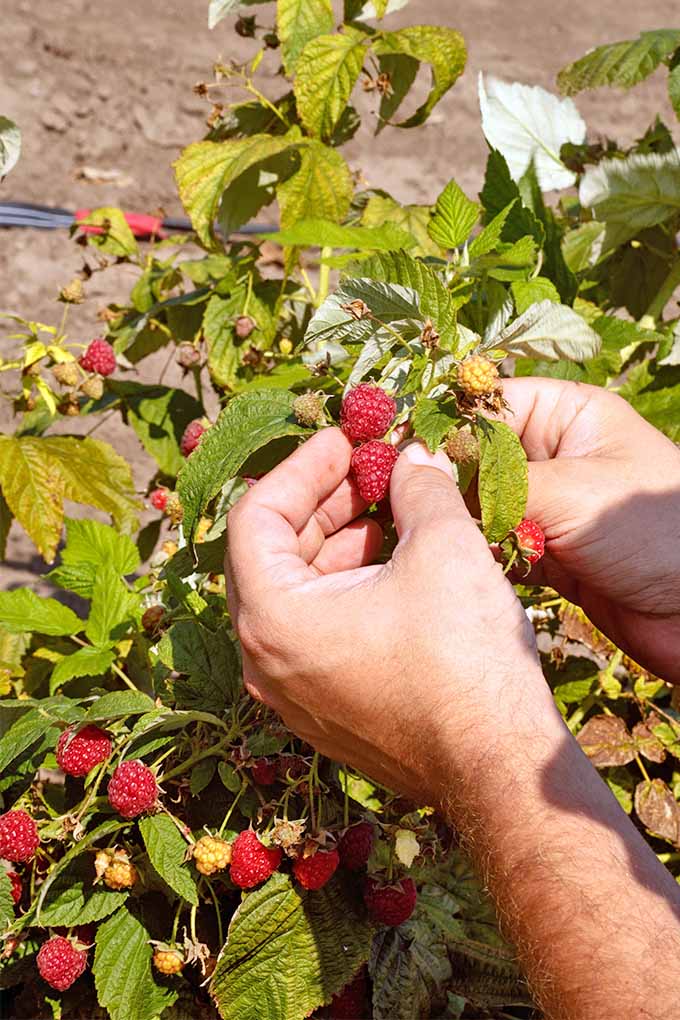
Whether you’re reminiscing about reliving the memory of making homemade jam with your grandma, or you’re eager to share the joys of sun-ripened raspberries with your own kids, this is a project that the whole family can enjoy, and the rewards are sweet.
For more information on growing and caring for raspberries, please visit our growing guide. Growing your own perennial fruit at home doesn’t have to be difficult. Seriously!
To share your victories, as well as any questions or concerns, please do not hesitate to reach out in the comments below. We love hearing from you!
And for more information about growing berries in your garden, check out these guides next:
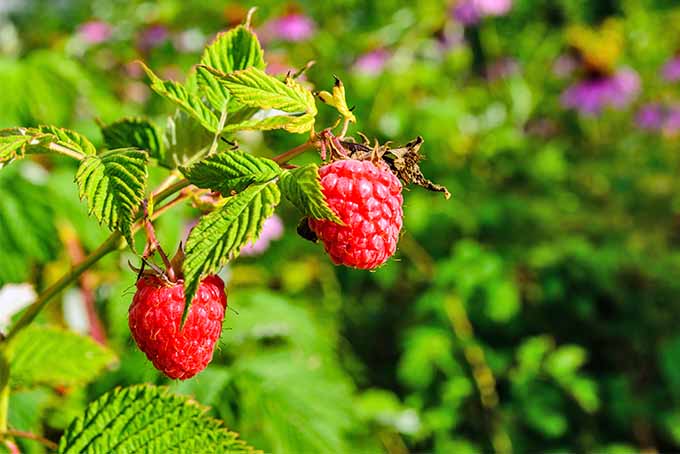
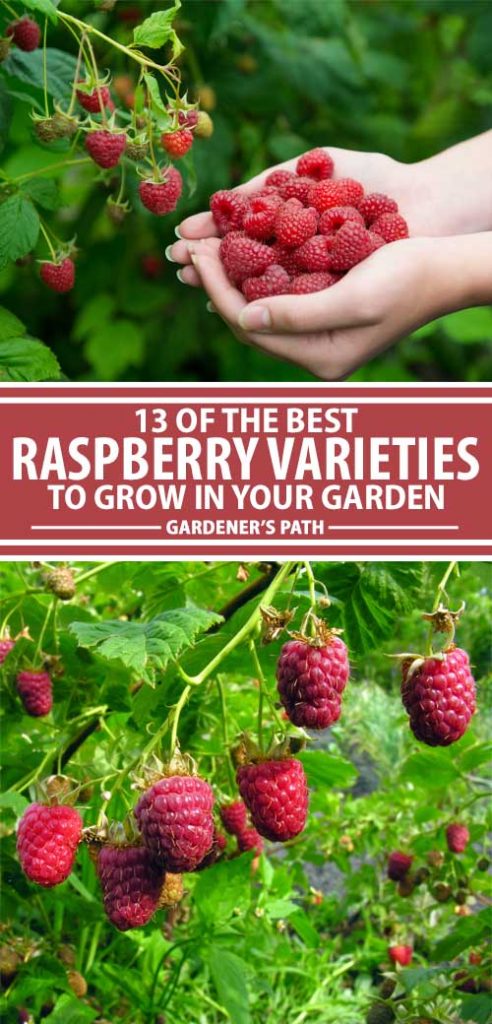
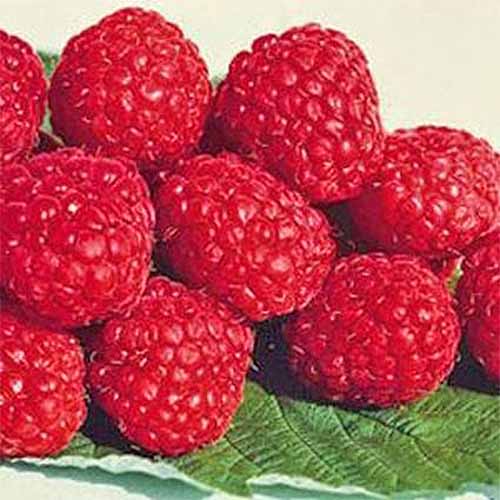
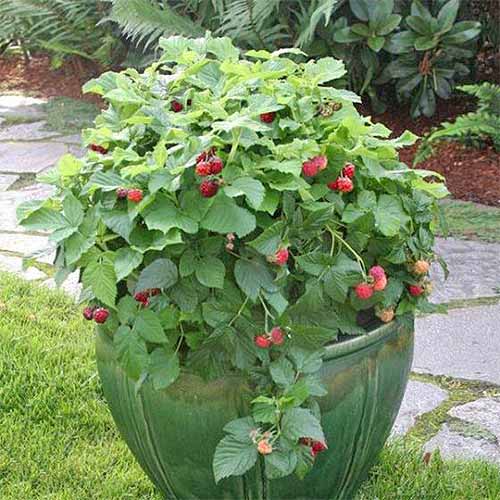


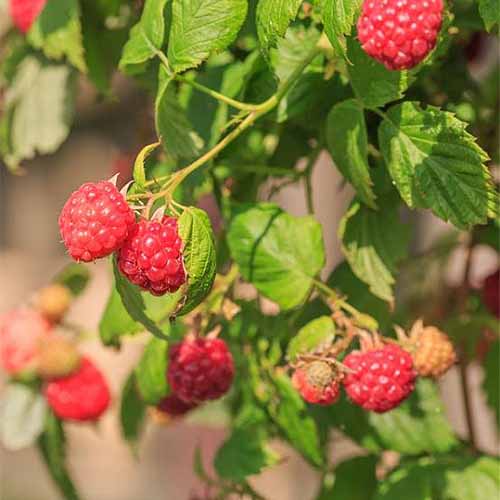


Jewel is Rubus occidentalis (eastern / Midwestern black raspberry), not R.ideaus (red raspberry). It is also a floricane bearer, with one large crop on 2nd year canes (around July 4 in Chicago). To my knowledge, “Niwot” is the only commercially available primocane/everbearing black raspberry. Black raspberries have (like most or all tasty red ones) disappointing floral displays and fall color (green–> wilted green/brown after frost), but have very nice, purple-red winter stem color. Dormanred is not R. ideaus but rather a hybrid of that species with a low chill, heat and humidity tolerant species from southern China. Fortunately it got… Read more »
Hi Allison,
Thanks for the great article with beautiful photos! I originally thought I might have to stick to summer bearing varieties but I was pleasantly surprised to see that I can actually grow some of the ever bearing cultivars here in Jersey. Thank you for all your insight.
You’re welcome, Querina. Good luck with the berries!
Thank you Allison,
We recently moved and know we will miss our Raspberries. Only one of the varieties has it referenced that it is thornless. Does that indicate that the others do have thorns as has always been a stickler. Thanks,
Thanks for your message, Gary – I apologize that this wasn’t covered more thoroughly in our roundup on the initial go-round! I did a little additional research, and I’ve found that thornless raspberry varieties can be hard to find. ‘Raspberry Shortcake’ as well as ‘Joan J,’ ‘Dorman Red,’ and ‘Canby’ are all known to be thornless. ‘Polka,’ ‘Nova,’ ‘Cascade Delight,’ and ‘Encore’ are usually described as nearly thornless. Many gardeners are okay with running into the occasional spince on their ‘Nova’ plants (see more on this distinction to follow), whereas reviews of ‘Encore’ are riddled with complaints from growers with… Read more »
Thank you.
What about the Anne variety, are they thornless and am I able to grow them in a container/raised bed?
It’s a toss up between Joan J and Polka or Rasp. Shortcake and Anne
‘Anne’ raspberries do have thorns. This golden everbearing type can be grown in a container, preferably one that’s at least 24 inches wide. Depending on what growing zone you are located in, you might actually like to bring it indoors in the winter if you are growing in a container, to force a crop earlier in the spring. This type should also do well in a raised bed. ‘Shortcake’ is thornless, with a compact size, so it’s excellent for containers. ‘Joan J’ is known for producing large yields, but it can grow quite tall with a significant spread, and you… Read more »
Hi Allison. I have a nice blueberry plant in a large 24×15″ deep bucket which is coming in nicely; about 36″ tall now. My wife wants raspberries too but our yard isn’t all that big here in Chicago. I guess I could make room for the raspberries in-ground, but I was going to either transplant the blueberries into the ground this year and put some raspberries into that bucket or vice-versa. What do you recommend? Also, what variety would you recommend for my zone? I want the most bearing plant there is for our climate whether it be once or… Read more »
Hi Eddie, Either raspberries or blueberries can be grown in containers, as long as you’re able to give them the conditions that they need. The choice is really up to you, but you might find that the blueberry is easier to manage in-ground since it isn’t a bramble with canes that are eager to spread. In Chicago, you’re located in Zone 5b. ‘Dorman Red’ is a fast-growing and high-yielding cultivar with red berries that should do well in your zone, ‘Raspberry Shortcake’ does well in containers, and ‘Summit’ is known for its sweet, tasty flavor. Would love to hear what… Read more »
I’m in NM and at a previous home had raspberries (not sure the type nor variety) but would cut them completely back after first frost and then would get berries in late August to first frost. I want to be able to mow them down each fall (easy care). Am I looking for everbearing or summer bearing?
Hi Linda, for a single, late summer crop, everbearing canes are what you want.
Cut all the canes back hard to about 1 inch from the ground when dormant (winter to early spring), and they’ll produce one large crop late in the growing season.
Hope this helps, and thanks for asking!
I want to grow red raspberries to relive my childhood heaven in Indiana but now live in the redwoods in N California with only 5 hrs max of direct sunlight–zone 9 on the coast. Which variety might do best? Dorman Red AND cascade delight are for my zone 9 but I’m a bit cooler being 1 mile from the ocean–still warm but not often hot. What to do? Thanks for any info. ????
Cooler temperatures won’t hurt- both of the varieties you mentioned are suited to cooler zones, with Zone 9 being the upper range of what’s ideal for these cultivars. The cooler coastal climates of this part of California are often perfect for growing raspberries! However, the amount of sunlight that you have available may be an issue. In order to produce the best yields, a full sun location is recommended (6-8 hrs/day), with some shade provided as needed in cases of extreme heat or drought. This doesn’t mean you won’t be able to grow them at all, but you may need… Read more »
hello. jewel black raspberry is not everbearing. this is incorrect information. it produces berries on the 2nd years canes and only once a summer
Thanks for your note, Lor. The article has been updated.
I love this article! I’m so excited to try growing raspberries in the mountains of Utah for the kids
Thank you so much for your time and this information. It is much appreciated! I live in a valley just a few mile up river from zone 5 into zone 4. In the past we were accustomed to winter nights reaching below -24. Now, it is typically not less than -10. I have great soil and full sun. DH and I are seniors now so minimum care is best. But SWEET is what we want–that good old fashioned flavor of raspberries–just like the older ones from back in PA! In town friends get two blooms a summer, but we would… Read more »
is there such a plant called wild raspberries? I have tons of plants growing wild in my backyard and producing red fruit much like raspberries they have lots of thorns. How do you classify them?
Absolutely! It’s not possible to confirm the identify of these plants based on your description alone – we’d need to at least see photos and know a bit more about your location – but there are wild raspberries and other brambles that produce edible fruit. Foragers and wildlife are fans, but wild plants can also serve to introduce disease to cultivated plants, and they can be difficult to eradicate if that’s your goal, so there are potential downsides as well.